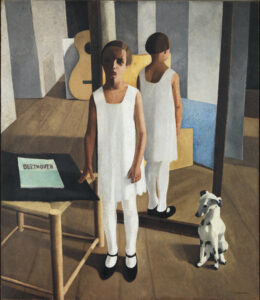The phases of Felice Casorati’s painting (Novara 1883 – Turin 1963) are the protagonists of the exhibition entitled “Felice Casorati. The concert of painting” held until July 2, 2023 at the Fondazione Magnani Rocca in Mamiano di Traversetolo. The idea behind the exhibition was music, imagining a dialogue between Luigi Magnani, father of the Foundation, composer, collector and music lover, especially Beethoven and Felice Casorati, musician and painter, united by the figure of the composer Alfredo Casella, master of Luigi Magnani and friend of Casorati. Among the major protagonists of Magic Realism, Casorati in his life between music and painting was an artist in which the innovation of the avant-garde has been able to merge in the tradition of the Return to order paying homage to the great artists from the past, while being characterized by a personal and cultured style. The attention to the different ages of the woman, accompanied by a detailed study of the body and the contrast between the nude and the softness of the clothes, characterizes much of the work, which is further enriched thanks to the introspective analysis of the characters lowered in suspended, magical and metaphysical environments.

Felice Casorati, Le signorine, 1912, mixed media on canvas (detail) 2022 © Archivio Fotografico – Fondazione Musei Civici di Venezia, Galleria Internazionale d’Arte Moderna di Ca’ Pesaro © Felice Casorati, by SIAE 2023
Skilled and talented in both music and painting, he presented in 1907 at the Venice Biennale, the work Ritratto della sorella Elvira (1907) which welcomes the viewer at the beginning of the exhibition. On a dark background, the bright white of the accessories that accompany the black dress stands out, of which Casorati portrays the draperies and the softness of the fabric with mastery. The figure, portrayed in profile, is illuminated by a glow that highlights the complexion and personality. Even in the following works, such as Le vecchie (1909) and Le ereditiere (1910), the latter presented at the 1910 Biennale, we note how Casorati has been able to innovate figurative painting of the nineteenth century, covering it with a marked personalization linked to the study of moods and the diversity of looks, revealing different stories and experiences of life lived. But Casorati’s experimentation continues and evolves, imbued also with the influence of Klimt and the Secessions, with particular attention to the verticality of the figures and the richness of the details and decorative elements, as can be observed in Notturno (1912-1913). Le signorine (1912) marks an important turning point in the pictorial language of the artist, who portrays four women, whose names are indicated at their feet, accompanied by a rich presence of objects characterizing the protagonists and their condition, flowers and books, which recall the paintings of the fifteenth century. The background of the painting is the majestic cedar fronds of Lebanon, present at the sight of the Verona studio, overlooking Piazza Bra.

Felice Casorati, Silvana Cenni, (detail), 1922, tempera on canvas, Torino, Collezione privata © Felice Casorati, by SIAE 2023
With the advent of the Twenties and the Return to Order, Casorati’s style changed, also influenced by the sadness resulting from the post-war period and the death of his father. In the work Maria Anna De Lisi (1919), the protagonist is at the center of the work, immersed in a geometric context, but at the same time abstract and metaphysical, characterized by the presence of cubes, easels and canvases, space that represents the artist’s study: a place of silence, study, reflection and artistic creation. Another emblematic work of Casorati’s work is Uova sul cassettone (1920), on which are represented fifteen eggs, white and perfectly elliptical, placed on a table that seems inclined, as from Cézanne’s lesson, in an unstable balance. The egg characterizes the poetics of the artist, emblematic symbol, represents the future opening of a new life, the expectation, the fragility, the perfection of the form, the contrast between solidity and precariousness, all concepts that seem to be embodied in the motto chosen by Casorati for his art: Numerus Mensura Pondus (Number, Measure, Weight). The exhibition continues with other works including Le due sorelle (Libro aperto e libro chiuso) (1921), exhibited in “Contemporary Italian Art” at the Pesaro Gallery in Milan, characterized by a diagonal construction of the image and by the contrast between the two sisters, with the same face, of which one appears young and naked while the second is an adult woman and dressed, accompanied by the presence of an open book with white pages still to be written at the feet of the young woman and a closed book on the side of her sister dressed. The figures are solid, almost reminiscent of the line of Sironi and the surrounding space is geometric, characterized by the succession of parallel planes. The geometric rigor and the homage to the ancient are elements that distinguish the famous Rosanna Cenni (1922).

Felice Casorati, Le uova sul cassettone, 1920,greasy tempera on board, private collection © Felice Casorati, by SIAE 2023
The lesson of the Return to Order was assimilated by Casorati, who pays homage to Piero della Francesca, setting the hieratic protagonist at the center of the scene, sitting on an imposing and geometric chair whose armrests are decorated with a drape of floral designs, at whose feet it places several volumes of which one open. The verticality of the figure, like that of the laying of hands, gives a sense of ascension to the work that accompanies the viewer behind the protagonist, beyond the window, on a hilly landscape, in which is represented an architecture dear to the artist, revisited according to strong references to the Renaissance. The work results in a perfect compositional balance; the brightness of the woman’s dress contrasts with the darker colors that outline the surrounding environment in an atmosphere suspended between reality and magic, without clear distinction, thus outlining the Magic Realism that in those years characterized the production of many artists, including Casorati. In Concerto (1924), the same model is represented in different positions, as in a ballet, almost echoing the opera The dance (1909) by Matisse, with the warm color backgrounds chosen by the artist. The harmonious volumetry of the bodies moves in space from geometric perspectives, where there are intervals of light and shadow. The element of music is present not only thanks to the harmony of the composition, from which it seems to emanate a piece of music, but also thanks to the presence of the instrument, which evokes the guitar of the Suonatore di liuto (1595-1597) by Caravaggio. Conversazione platonica (1925) represents a dialogue between a man and a woman lying down, in a pose that recalls the Venus of Titian and the bust that seems to evoke the Aphrodite of Cyrene, whose chalk the artist kept in his studio. The man’s face is hidden by the hat, as he looks down at the woman in front of him. The composition unfolds on the diagonals of the woman and the man who meet in the center of the canvas, where the silent conversation between the two takes place, in an abstract, universal and metaphysical environment.

Felice Casorati, Beethoven, 1928, Rovereto, MART, Museum of modern and contemporary art of Trento and Rovereto © Felice Casorati, by SIAE 2023
Beethoven (1928) places the link between Casorati and Magnani given by the music and the esteem towards the German composer. The protagonist of the painting, a little girl with a white dress, stands at the center of the scene and, with a melancholy look, looks at the viewer capturing him in the work, in which there are several planes that follow each other and objects, such as the mirror that portrays her shoulders and a guitar, partially visible, walls with side openings that expand the pictorial space, expanding the volumes. The reflections of the figures or the presence of mirrors are recurring elements in Casorati’s art, which expand the perspective planes of the work and enhance some details, demonstrating the artist’s mastery in using such figurative and expressive means. We continue with pencil drawings until we arrive at the still lifes of the thirties, which Casorati paints with “conscious naturalness” as indicated by the artist himself, then passing to Sorelle Pontorno (1937), Uova su fondo rosso (1953) and sketches for plays of the Teatro alla Scala in Milan to which he had dedicated himself as a set designer, exploiting his remarkable drawing skills. “Felice Casorati. The concert of painting” thanks to the richness and importance of the works present, allows you to plunge into the Magic Realism of one of the greatest artists of the Italian twentieth century and appreciate its stylistic refinement, attention to the different ages of life, the balance of the composition and the erudition of the contents, which enrich even more the meanings linked to the works.
Info:
Felice Casorati, The concert of painting
17/03/2023 – 02/07/2023
Fondazione Magnani Rocca
Traversetolo (Parma)

She has a scientific background, but also a great passion for art, which she loves to tell, admiring all its expressions.






NO COMMENT